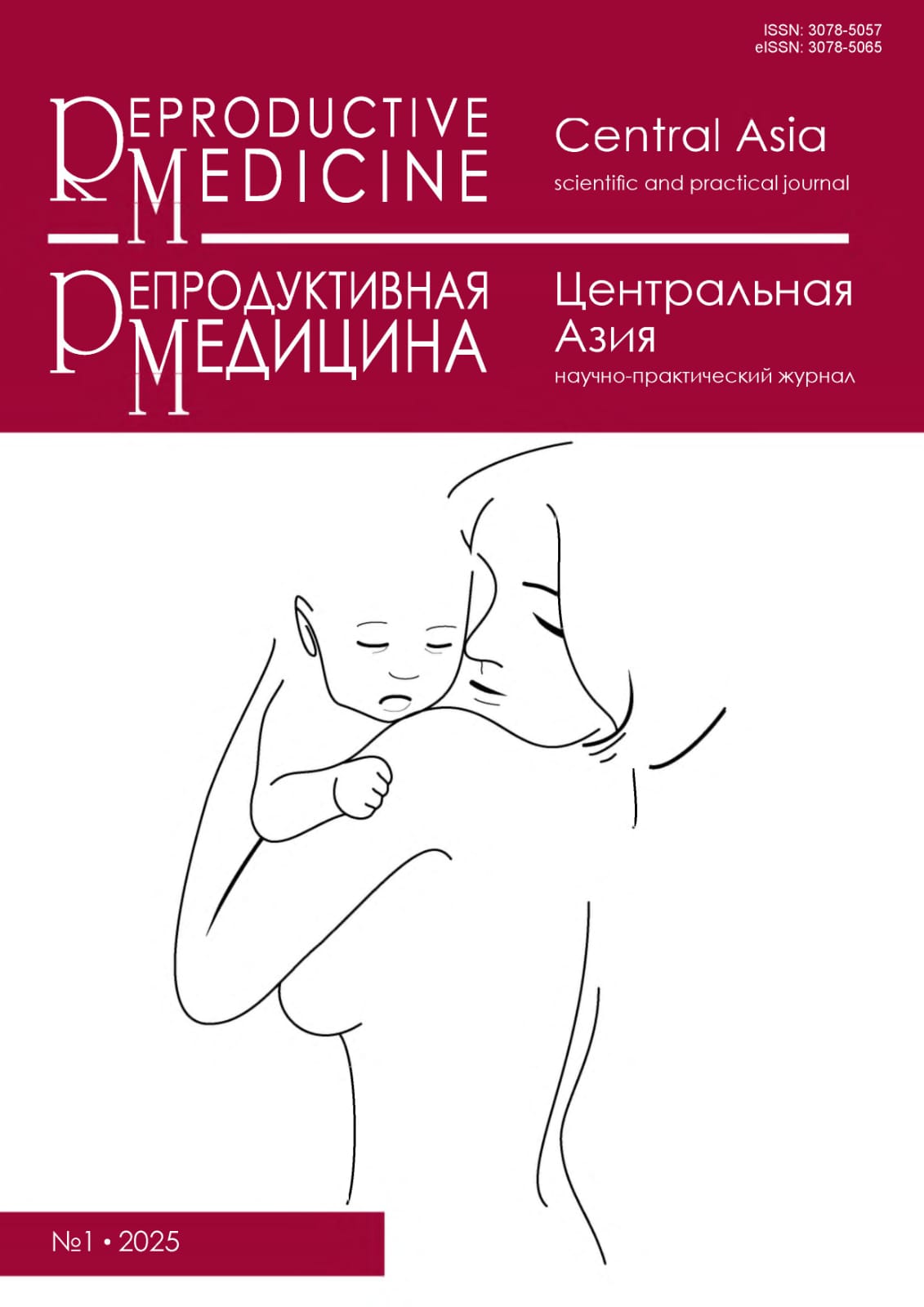Clinical prospects for using artificial intelligence in urogynecology: a literature review
DOI:
https://doi.org/10.37800/RM.1.2025.465Keywords:
artificial intelligence, deep learning, natural language processing, urogynecology, gynecologyAbstract
Relevance: Over the past decades, the application of artificial intelligence (AI) in medicine has expanded significantly, encompassing almost all medical disciplines. AI technologies are applied in various fields of obstetrics and gynecology, including general obstetrics, gynecological surgery, prenatal ultrasound, and assisted reproductive technologies, among others. AI is one of the most rapidly evolving medical technologies, especially in specialties where imaging plays a key role. AI has already demonstrated significant potential in gynecology in several areas, particularly oncology, where studies have shown promising results. However, in urogynecology, despite the widespread use of visual diagnostic methods and tests for assessing pelvic floor condition in women, significantly fewer studies have been conducted on AI applications.
The study aimed to analyze the current status of AI usage in obstetrics and gynecology, assess the achievements of machine learning that contribute to the development of this field, identify existing limitations, and determine the prospects for further application of AI.
Materials and Methods: A search for scientific publications was conducted in the PubMed, Scopus, Google Scholar, and e-Library databases in English, Kazakh, and Russian languages using keywords and medical subject headings (MeSH) among materials published from January 1, 2020, to February 10, 2025. A total of 48 articles were included in the review.
Results: This review analyzes the transformative impact of AI technologies on the diagnosis, treatment, and management of urogynecological disorders. It examines key advancements in imaging methods, predictive analytics, and AI-based personalized medicine, emphasizing their role in improving diagnostic accuracy, enhancing prenatal care, and optimizing urogynecological interventions.
Conclusion: The literature review highlights the significant potential of AI in enhancing medical care standards in urogynecology to improve clinical outcomes and overall women’s reproductive health. The presented analysis of current and future AI usage demonstrates the need for further research and the development of strategies to safely and effectively integrate these technologies into clinical practice.
References
Brandão M, Mendes F, Martins M, Cardoso P, Macedo G, Mascarenhas T, Mascarenhas Saraiva M. Revolutionizing Women’s Health: A Comprehensive Review of Artificial Intelligence Advancements in Gynecology. J Clin Med. 2024;13. https://doi.org/10.3390/jcm13041061
Mota J, Almeida MJ, Mendes F, Martins M, Ribeiro T, Afonso J, Cardoso P, Cardoso H, Andrade P, Ferreira J, Mascarenhas M., Macedo G. From Data to Insights: How Is AI Revolutionizing Small-Bowel Endoscopy? Diagnostics. 2024;14(3):291. https://doi.org/10.3390/diagnostics14030291
Amisha, Malik P, Pathania M, Rathaur V. Overview of artificial intelligence in medicine. J Family Med Prim Care. 2019;8(7):2328-2331.
https://doi.org/10.4103/jfmpc.jfmpc_440_19
Basu K, Sinha R, Ong A, Basu T. Artificial intelligence: How is it changing medical sciences and its future? Indian J Dermatol. 2020;65(5):365-370.
https://doi.org/10.4103/ijd.IJD_421_20
Iftikhar PM, Kuijpers M V, Khayyat A, Iftikhar A, DeGouvia De Sa M. Artificial Intelligence: A New Paradigm in Obstetrics and Gynecology Research and Clinical Practice. Cureus. 2020;12(2):e7124.
https://doi.org/10.7759/cureus.7124
Rajkomar A, Dean J, Kohane I. Machine Learning in Medicine. New Engl J Med. 2019;380:14.
https://doi.org/10.1056/nejmra1814259
Zimmer-Stelmach A, Zak J, Pawlosek A, Rosner-Tenerowicz A, Budny-Winska J, Pomorski M, Fuchs T, Zimmer M. The Application of Artificial Intelligence-Assisted Colposcopy in a Tertiary Care Hospital within a Cervical Pathology Diagnostic Unit. Diagnostics. 2022;12(1):106.
https://doi.org/10.3390/diagnostics12010106
Turing AM. Computing Machinery and Intelligence. The MIT Press eBooks: 1990. https://doi.org/10.7551/mitpress/6928.003.0012.
McCarthy J, Minsky ML, Rochester N, Shannon CE. A Proposal for the Dartmouth Summer Research Project on Artificial Intelligence, August 31, 1955. AI Magazine. 2006;27(4):12.
https://doi.org/10.1609/aimag.v27i4.1904
Jiang F, Jiang Y, Zhi H, Dong Y, Li H, Ma S, Wang Y, Dong Q, Shen H, Wang Y. Artificial intelligence in healthcare: Past, present and future. Stroke Vasc Neurol. 2017;2.
https://doi.org/10.1136/svn-2017-000101
Jayatilake SMDAC, Ganegoda GU. Involvement of Machine Learning Tools in Healthcare Decision Making. J Healthc Eng. 2021;2021(1):1-20.
https://doi.org/10.1155/2021/6679512
Jordan MI, Mitchell TM. Machine learning: Trends, perspectives, and prospects. Science. 2015;349(6245):255-260.
https://doi.org/10.1126/science.aaa8415
Saw SN, Ng KH. Current challenges of implementing artificial intelligence in medical imaging. Physica Med. 2022;100:12-17.
https://doi.org/10.1016/j.ejmp.2022.06.003
Shen YT, Chen L, Yue WW, Xu HX. Artificial intelligence in ultrasound. Eur J Radiol. 2021;139:109717.
https://doi.org/10.1016/j.ejrad.2021.109717
Yoon I, Gupta N. Pelvic Prolapse Imaging [Internet]. Treasure Island (FL): StatPearls Publishing; 2023. Available from:
https://www.ncbi.nlm.nih.gov/books/NBK551513/
Akkus Z, Cai J, Boonrod A, Zeinoddini A, Weston AD, Philbrick KA, Erickson BJ. A Survey of Deep-Learning Applications in Ultrasound: Artificial Intelligence–Powered Ultrasound for Improving Clinical Workflow. J Am College Radiol. 2019;16(9):138-1328. https://doi.org/10.1016/j.jacr.2019.06.004
Zaharchuk G, Davidzon G. Artificial Intelligence for Optimization and Interpretation of PET/CT and PET/MR Images. Semin Nucl Med. 2021;51(2):134-142.
https://doi.org/10.1053/j.semnuclmed.2020.10.001
Paudyal R, Shah AD, Akin O, Do RKG, Konar AS, Hatzoglou V, Mahmood U, Lee N, Wong RJ, Banerjee S, Shin J, Veeraraghavan H, Shukla-Dave A. Artificial Intelligence in CT and MR Imaging for Oncological Applications. Cancers (Basel).2023;15(9):2573.
https://doi.org/10.3390/cancers15092573
Kurdoğlu M, Khaki A. The Use of Artificial Intelligence in Urogynecology. Intl J Women’s Health Reprod Sci. 2024;12:001-002.
https://doi.org/10.15296/ijwhr.2024.6003
Battineni G, Chintalapudi N, Ricci G, Ruocco C, Amenta F. Exploring the integration of artificial intelligence (AI) and augmented reality (AR) in maritime medicine. Artif Intell Rev. 2024;57:100.
https://doi.org/10.1007/s10462-024-10735-0
Rajesh A, Asaad M. Artificial Intelligence and Machine Learning in Surgery. Am Surg. 2023;89(1):9-10.
https://doi.org/10.1177/00031348221117024
Daykan Y, O’Reilly BA. The role of artificial intelligence in the future of urogynecology. Int Urogynecol J. 2023;34:1663-1666.
https://doi.org/10.1007/s00192-023-05612-3
Seval MM, Varlı B. Current developments in artificial intelligence from obstetrics and gynecology to urogynecology. Front Med (Lausanne). 2023;10:1098205.
https://doi.org/10.3389/fmed.2023.1098205
Nekooeimehr I, Lai-Yuen S, Bao P, Weitzenfeld A, Hart S. Automated contour tracking and trajectory classification of pelvic organs on dynamic MRI. J Med Imaging. 2018;5(1):014008.
https://doi.org/10.1117/1.jmi.5.1.014008
Onal S, Lai-Yuen S, Bao P, Weitzenfeld A, Greene K, Kedar R, Hart S. Assessment of a semiautomated pelvic floor measurement model for evaluating pelvic organ prolapse on MRI. Int Urogynecol J. 2014;25:767-773.
https://doi.org/10.1007/s00192-013-2287-4
Wang X, He D, Feng F, Ashton-Miller JA, DeLancey JOL, Luo J. Multi-label classification of pelvic organ prolapse using stress magnetic resonance imaging with deep learning. Int Urogynecol J. 2022;33:2869-2877.
https://doi.org/10.1007/s00192-021-05064-7
Zhang M, Lin X, Zheng Z, Chen Y, Ren Y, Zhang X. Artificial intelligence models derived from 2D transperineal ultrasound images in the clinical diagnosis of stress urinary incontinence. Int Urogynecol J. 2022;33:1179-1185.
https://doi.org/10.1007/s00192-021-04859-y
Mascarenhas M, Afonso JPL, Ribeiro T, Cardoso P, Mendes F, Martins M, Andrade A, Cardoso H, Ferreira J, Macedo G. S699 Deep Learning and Minimally Invasive Endoscopy – Panendoscopic Detection of Pleomorphic Lesions. Am J Gastroenterol. 2023;118:123-138.
https://doi.org/10.14309/01.ajg.0000952436.94054.86.
Negassi M, Suarez-Ibarrola R, Hein S, Miernik A, Reiterer A. Application of artificial neural networks for automated analysis of cystoscopic images: a review of the current status and future prospects. World J Urol. 2020;38:2349-2358.
https://doi.org/10.1007/s00345-019-03059-0
Aramendía-Vidaurreta V, Cabeza R, Villanueva A, Navallas J, Alcázar JL. Ultrasound Image Discrimination between Benign and Malignant Adnexal Masses Based on a Neural Network Approach. Ultrasound Med Biol. 2016;42(3):742-752.
https://doi.org/10.1016/j.ultrasmedbio.2015.11.014
Moawad G, Tyan P, Louie M. Artificial intelligence and augmented reality in gynecology. Curr Opin Obstet Gynecol. 2019;31(5):345-348.
https://doi.org/10.1097/GCO.0000000000000559
Taylor RA, Moore CL, Cheung KH, Brandt C. Predicting urinary tract infections in the emergency department with machine learning. PLoS One. 2018;13(3):e0194085.
https://doi.org/10.1371/journal.pone.0194085
Goździkiewicz N, Zwolińska D, Polak-Jonkisz D. The Use of Artificial Intelligence Algorithms in the Diagnosis of Urinary Tract Infections—A Literature Review. J Clin Med. 2022;11.
https://doi.org/10.3390/jcm11102734
Cherukuri S, Jajoo S, Dewani D. The International Ovarian Tumor Analysis-Assessment of Different Neoplasias in the Adnexa (IOTA-ADNEX) Model Assessment for Risk of Ovarian Malignancy in Adnexal Masses. Cureus. 2022;14(11):e31194.
https://doi.org/10.7759/cureus.31194
Jones OT, Calanzani N, Saji S, Duffy SW, Emery J, Hamilton W, Singh H, de Wit NJ, Walter FM. Artificial intelligence techniques that may be applied to primary care data to facilitate earlier diagnosis of cancer: Systematic review. J Med Internet Res. 2021;23(3).
Bentaleb J, Larouche M. Innovative use of artificial intelligence in urogynecology. Int Urogynecol J. 2020;31:1287-1288.
https://doi.org/10.1007/s00192-020-04243-2
Zattoni F, Carletti F, Randazzo G, Tuminello A, Betto G, Novara G, Dal Moro F. Potential Applications of New Headsets for Virtual and Augmented Reality in Urology. Eur Urol Focus. 2024;10(4):594-598.
https://doi.org/10.1016/j.euf.2023.12.003
Baessler K, Bortolini M. “The role of artificial intelligence in the future of urogynecology” by Yair Daykan, Barry A. O’Reilly. Int Urogynecol J. 2023;34:1667. https://doi.org/10.1007/s00192-023-05624-z
Polat G, Arslan HK. Artificial Intelligence in Clinical and Surgical Gynecology. İstanbul Gelişim Univ J Health Sci. 2024;21:1232-1241.
https://doi.org/10.38079/igusabder.1291375
Mascagni P, Alapatt D, Sestini L, Altieri MS, Madani A, Watanabe Y, Alseidi A, Redan JA, Alfieri S, Costmagna G, Boškoski I, Padoy N, Hashimoto DA. Computer vision in surgery: from potential to clinical value. NPJ Digit Med. 2022;5:163.
https://doi.org/10.1038/s41746-022-00707-5
Guni A, Varma P, Zhang J, Fehervari M, Ashrafian H. Artificial Intelligence in Surgery: The Future is Now. Eur Surg Res. 2024;65(1):22-39.
https://doi.org/10.1159/000536393
Kitaguchi D, Watanabe Y, Madani A, Hashimoto DA, Meireles OR, Takeshita N, Mori K, Ito M; Computer Vision in Surgery International Collaborative. Artificial Intelligence for Computer Vision in Surgery: A Call for Developing Reporting Guidelines. Ann Surg. 2022;275(4):e609-e611.
https://doi.org/10.1097/SLA.0000000000005319
Eckhoff JA, Fuchs HF, Meireles OR. Application of artificial intelligence in oncologic surgery of the upper gastrointestinal tract. Onkologie. 2023;29:515-521.
https://doi.org/10.1007/s00761-023-01318-9
Serban N, Kupas D, Hajdu A, Török P, Harangi B. Distinguishing the Uterine Artery, the Ureter, and Nerves in Laparoscopic Surgical Images Using Ensembles of Binary Semantic Segmentation Networks. Sensors. 2024; 24(9):2926.
https://doi.org/10.3390/s24092926
Narihiro S, Kitaguchi D, Hasegawa H, Takeshita N, Ito M. Deep Learning-Based Real-Time Ureter Identification in Laparoscopic Colorectal Surgery. Dis Colon Rectum. 2024;67(10):1596-1599.
https://doi:10.1097/DCR.0000000000003335
Kitaguchi D, Takeshita N, Hasegawa H, Ito M. Artificial intelligence-based computer vision in surgery: Recent advances and future perspectives. Ann Gastroenterol Surg. 2021;6(1):29-36.
https://doi:10.1002/ags3.12513
Yu F, Song E, Liu H, Zhu J, Hung CC. Laparoscopic Image-Guided System Based on Multispectral Imaging for the Ureter Detection. IEEE Access 2019;7:3800-3809. https://doi.org/10.1109/ACCESS.2018.2889138.
Sheyn D, Ju M, Zhang S, Anyaeche C, Hijaz A, Mangel J, Sangeeta M, Britt C, El-Nashar S, Soumya R. Development and Validation of a Machine Learning Algorithm for Predicting Response to Anticholinergic Medications for Overactive Bladder Syndrome. Obstet Gynecol. 2019;134(5):946-957.
Downloads
Published
How to Cite
Issue
Section
License
Copyright (c) 2025 The rights to a manuscript accepted for publication are transferred to the Journal Publisher. When reprinting all or part of the material, the author must refer to the primary publication in this journal.

This work is licensed under a Creative Commons Attribution-NonCommercial-NoDerivatives 4.0 International License.
The articles published in this Journal are licensed under the CC BY-NC-ND 4.0 (Creative Commons Attribution – Non-Commercial – No Derivatives 4.0 International) license, which provides for their non-commercial use only. Under this license, users have the right to copy and distribute the material in copyright but are not permitted to modify or use it for commercial purposes. Full details on the licensing are available at https://creativecommons.org/licenses/by-nc-nd/4.0/.




